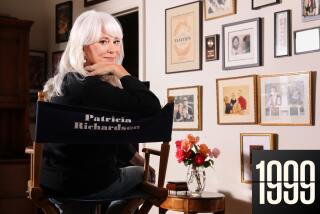Focus : Down Home : ABC’S HOW-TO SHOW RELIES ON PRACTICALITY--AND WORD OF MOUTH
They say there’s no place like home.
And if they’re talking about places in TV-land, executive producer of ABC’s “Home” show Woody Fraser would have to agree. Where else on the airwaves can you learn how to crackle-finish a chair, grill a pineapple, do roller-blade aerobics, fix the air conditioner, make the perfect cup of cappuccino, take ticks off the dog, talk to the kids about sex and see a woman casually gabbing on the phone while undergoing liposuction?
“Viewers say we’re an oasis,” says the show’s 1988 creator (and a former executive producer of “Good Morning America”) who has been back “Home” since last fall after a 16-month absence. Indeed, the show may be distinctive in a talky, soapy, game-showy daytime TV world:
Whether it’s paint the room in stripes or launch a teddy bear on a trip around the world, “Home” aims to get its targeted audience--women at home--into high gear. “What we have here is a show about ideas that women can apply to their lives, and that in itself makes the show different,” Fraser says.
Fraser likes when viewers “just do it.” There was the unemployed couple who saw a segment on a crafts mall and started their own booming mall, and the woman who decorated a nursery on a shoestring with “Home” tips.
“That kind of thing happens to us literally thousand of times,” Fraser says. “That’s my kind of television--catalytic television. I’m a salesman. I’m selling you on getting off your duff and doing something about something.”
The sales pitch seems to be working again; “Home” hasn’t always been this sweet. The show has had its share of troubles--enduring host changes, producer changes, content changes and even a cancellation last December. But Gary Collins, who has co-hosted since 1989 and is now paired with Sarah Purcell, says the show has gone back to basics.
“We’re getting back to providing a service for our viewers,” says Collins, father of a 24-year-old daughter. For awhile, the show focused more on people stories and less on how-to’s.
Ratings research shows that the program is picking up women in the coveted-by-advertisers 18-34 range. That’s just what ABC wants. “The show is in very good shape, but word has to get back to the loyal viewers who strayed,” says Mary Alice Dwyer-Dobbin, executive vice president of ABC daytime.
The remaining loyal audience is 4 million-strong a week. They’re greeted each day by Collins and Purcell, live from a comfy set where the tone is homey, too. “If you were to pick a geographic description, I’d say we’d be sort of Midwestern,” says Collins.
Purcell, a mother of two sons, 3 and 14, takes a more personal approach to hosting. “The show’s right where my heart is,” she says. “I rip those tips right out of the script.”
The hosts are joined by a big family. Meet just some of them: There’s Kitty Bartholomew, the lively hands-on decorator, who might redo a dilapidated house. She’s a devotee of the “Home” philosophy: “I’m totally committed to No. 1, information. Passionately.”
Meet crafts expert Carol Duvall, and “Movie Mom” Nora Fraser (an ex-wife of Fraser) who will tell you not to take kids to “Jurassic Park.” There’s green grocer Curtis Aikens on strawberries.
And Dr. Art Ulene, who might talk about breast cancer. “The purpose of my medical stories is to empower viewers with information that they can use in their daily lives,” Ulene says. Ulene’s segment on the Heimlich maneuver saved the life of a 6-year-old boy who came on the show to thank the doctor. “That was truly the most moving experience of my medical career. I’ll tell you without any shame I cried.”
Fashion guru Paula McClure might hold a fashion show on boxer shorts. That day Collins will certainly appear in his own sexy undies.
Such yukking-it-up is important, explains Fraser, the father of eight children. “The yin and the yang of this show is that it’s information-oriented, but I have to do it in an entertaining way.”
The “Home” family’s energy can get even the most uninitiated into action. After two weeks of watching “Home,” this non-craftsy reporter slipcovered a chair with pins and a bedsheet and made an herb garden in a strawberry pot.
“If I get you to watch, I usually have you,” Fraser says. He doesn’t worry much about competition from the new morning talk show “John & Leeza From Hollywood” on NBC; he does worry about matching them in promotion. “My biggest challenge is to get the word out.”
“Home” viewers can get hooked. When the show was canceled last December, 27,000 of them wrote in to save it.
Fraser says a direct relationship with viewers is key. A woman might call in on the air to ask hint-wiz Heloise how to get candle wax off a tablecloth.
ABC’s Dwyer-Dobbin likes the interaction: “I’d like to see even more contact with the grass-roots audience and even greater sensitivity to that woman at home.”
Does “Home,” geared to that woman at home, reinforce stereotyped roles? Purcell says no. “If we can speak to the women who are courageous enough in the ‘90s to stay home with their children ... I want to be there to support them.”
“Home” handyman Carl Mueller makes the show “as non-sexist as I can. I’m trying to empower women that anybody, regardless of their gender, can do these things.”
To Fraser, the show is not retro, but au courant , in tune with ‘90s-style frugality. “Home” also confronts ‘90s issues: AIDS and frozen embryos, to name two. “A lot of people may perceive the show as being all how to set a table ... it’s really so much more than that,” he says.
“Home” airs weekdays at 10 a.m. on ABC.
More to Read
The complete guide to home viewing
Get Screen Gab for everything about the TV shows and streaming movies everyone’s talking about.
You may occasionally receive promotional content from the Los Angeles Times.






